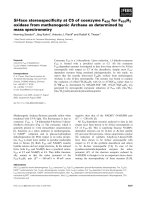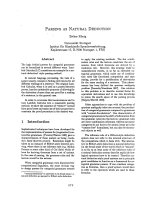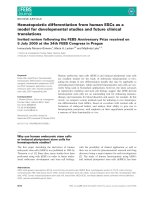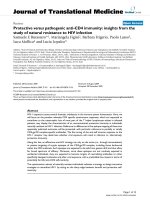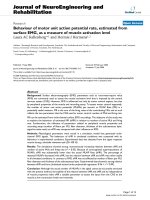Betacyanins from hylocereus undatus as natural food colorants
Bạn đang xem bản rút gọn của tài liệu. Xem và tải ngay bản đầy đủ của tài liệu tại đây (1.46 MB, 111 trang )
BETACYANINS FROM HYLOCEREUS UNDATUS
AS NATURAL FOOD COLORANTS
LIM TZE HAN
B.S.c. (Hons), NUS
A THESIS SUBMITTED
FOR THE DEGREE OF MASTER OF SCIENCE
DEPARTMENT OF CHEMISTRY
NATIONAL UNIVERSITY OF SINGAPORE
2004
I
ACKNOWLEDGEMENTS
“… I would like to express my deepest gratitude to the
Department of Chemistry, NUS for financial support throughout
my candidature. Many thanks to my supervisor, Associate
Professor Philip Barlow for his guidance throughout the course
of the project. I am deeply indebted to Mdm Lee Chooi Lan for
her kindness, understanding and help throughout my four years
in FST, NUS (2001-04). Finally, to my lab-mates and best pals,
Cui Min, Tay Sok Li and Soong Yean Yean, thank you for your
wonderful company and emotional support throughout the three
years…”
II
CONTENTS
1. INTRODUCTION
Page
1.1 The role of food colorants
1 -- 2
1.2 Natural food colorants
2 -- 5
1.3 Color measurements
6 -- 11
1.4 Betalains
11 -- 15
2. LITERATURE REVIEW
2.1 Discovery of Betalains
17 -- 21
2.2 Developments following discovery
2.2.3 Development of standard analytical procedures
22 --23
24 -- 28
28 -- 31
2.3 Avenues for further research
31 -- 34
3. AIMS AND OBJECTIVES
35 -- 36
2.2.1 Bioactivity studies
2.2.2 Food chemistry of betalains
4. MATERIALS AND METHODS
4.1 Reagents and solvents
4.2 Instrumentation
37
37 -- 39
4.3 Sample preparation
39
4.4 Extraction methods
39 -- 40
4.5 Analysis
40 -- 41
I
5. RESULTS AND DISCUSSION
5.1 Preliminary studies
42
5.1.4 Temperature studies
42 -- 43
43
43 – 45
45 -- 46
5.2 Extraction
47 -- 49
5.3 Analytical Methodology
50 -- 52
5.4 Comparison of shelf-life
53 - 55
5.1.1 Hue stability during storage
5.1.2 Hue stability in the pH environment of common food systems
5.1.3 Metal ion studies
5.5 Temperature studies
5.5.1 Hue stability at 50ºC
5.5.1 Hue stability at 70ºC
5.5.1 Hue stability at 90ºC
6. CONCLUSION
56 -- 58
59 -- 61
62 -- 64
65
7. SUGGESTIONS FOR FUTURE WORK
7.1 Betanidin as a possible vehicle for drug delivery
66 -- 68
7.2 Total synthesis of betanin
68 -- 69
8. BIBLOGRAPHY
70 – 72
9. APPENDIX
73 -- 90
II
SUMMARY
Hylocereus undatus is an epiphytic cacti with brightly colored fruits. These fruits,
known by various names such as Dragon fruit, Pitaya or Strawberry cactus are
harvested as a food crop in Vietnam, Australia and in South and Central America
from where it originated from. The fruit peel is known to contain betacyanins,
naturally occurring red pigments that are known to be non-toxic. In this project, the
feasibility of employing the fruit peel as a source of natural colorants for coloring
foods is investigated. Compared with betacyanins from beet root, currently the only
commercially available betacyanin-based natural food colorant, betacyanins from
Hylocereus undatus imported from Vietnam was found to be capable of superior shelf
life even in the absence of refrigeration. Stability under commonly encountered food
processing conditions was also demonstrated with the exception of exposure to
elevated temperatures. Therefore, while the scope of application of these pigments
remained confined to foods that experience minimal heat processing e.g. ice-cream,
fizzy drinks etc, favorable properties for longer and less costly storage was
demonstrated. Immense potential as such, exists, for the development of commercial
natural food colorants derived from such pigments.
III
III
LIST OF TABLES
Pg No.
Table No.
1
Classification of naturally-occurring pigments in
accordance to structural class
5
2
Chemical species selected for metal ion studies
42
IV
LIST OF FIGURES
Fig No.
Pg No.
1.1
Representative structure of azo-dyes
3
1.2
Examples of azo-dyes employed as food colorants
3
1.3
The observer situation
6
1.4
Schematic representation of color measurement using
a spectrophotometer equipped with a spectral sensor
7
1.5
The values of the three distribution coefficients at
various wavelengths in the visible spectrum
8
1.6
Munsell color chips, the basis of the Munsell color space.
9
1.7
An illustration of the various ways in which light can interact
with a given material
11
1.8
Representative structure of betalains and betalamic acid
12
1.9
Canonical forms of a representative 1,7-diazaheptamethin
molecular system
12
1.10
General structures of betacyanins
13
1.11
(a) Hydrolysis of betalains into amines and betalamic acid
(b) Degradation cascade of betalains
13
14
1.12
Molecular structure of betanin and betanidin
15
1.13
Molecular structure of betanin and gomphrenin
15
1.14
Formation of betaxanthins by Schiff base condensation
2.1
Hypothetical structure of a "nitrogeneous anthocyanin"
16
2.2
Structure of cyclodopa
16
2.3
Structure of 4-methyl chelidamic acid
17
V
2.4
H NMR spectra of pentamethylneobetanin
18
2.5
The structure of betanin and its aglycone, betanidin
18
2.6
The chemistry behind Mabry's experiments in 1964
19
2.7
The proposed biosynthetic pathway for betalains
20
2.8
Quenching of radicals by betanidin
22
2.9
Chromophore structures for betacyanins and betaxanthins
23
2.10
Hydroysis of betanidin by alkali
24
2.11
Degradation of betanidin in high Aw environments
25
2.12
Pigment regeneration via Schiff base formation
25
2.13
Decarboxylation of betacyanins
26
2.14
Representation of the structures of acylated and
non-acylated betacyanins
27
2.15
Typical procedure for the analysis of betalains
28
2.16
Preparing betaxanthins for the specific delivery of
amino acids
32
5.1
Changes in hue as a function of changing pH of 0.01%
(w/v) BetX
41
5.2
Changes in hue of 0.01% (w/v) BetX following exposure
to selected metal ion species
42
5.3
Changes in the hue of jellies colored using 0.01% (w/v)
spiked with selected metal ion species
43
5.4
After exposure appearances of test samples subjected
to various temperature conditions
44
5.5
Graphical illustration of the effects of ascorbic acid on hue
conservation following the exposure of BetX solutions to
44
VI
elevated temperatures
5.6
Typical RP-thin layer chromatogram for (a) commercial
beet juice concentrate (b) co-spot consisting of a spot of
(a) and (c) and (c) pigment extracts from Dragon fruit peel
45
5.7
Munsell color space
48
5.8
Visual correlation yardstick for following changes in the
hue(s) of 0.01% (w/v) BetX
50
5.9
Apparent shelf-life of variously prepared betacyanin
extracts
53
5.10
Changes in hue of sample solutions at pH 3 following
exposure to increasing duration of exposure to a
temperature of 50ºC
54
5.11
Changes in hue of sample solutions at pH 4 following
exposure to increasing duration of exposure to a
temperature of 50ºC
55
5.12
Changes in hue of sample solutions at pH 5 following
exposure to increasing duration of exposure to a
temperature of 50ºC
55
5.13
Changes in hue of sample solutions at pH 6 following
exposure to increasing duration of exposure to a
temperature of 50ºC
56
5.14
Changes in hue of sample solutions at pH 7 following
exposure to increasing duration of exposure to a
temperature of 50ºC
56
5.15
Changes in hue of sample solutions at pH 3 following
exposure to increasing duration of exposure to a
temperature of 70ºC
57
5.16
Changes in hue of sample solutions at pH 4 following
exposure to increasing duration of exposure to a
temperature of 70ºC
58
5.17
Changes in hue of sample solutions at pH 5 following
58
VII
exposure to increasing duration of exposure to a
temperature of 70ºC
5.18
Changes in hue of sample solutions at pH 6 following
exposure to increasing duration of exposure to a
temperature of 70ºC
59
5.19
Changes in hue of sample solutions at pH 7 following
exposure to increasing duration of exposure to a
temperature of 70ºC
59
5.20
Changes in hue of sample solutions at pH 3 following
exposure to increasing duration of exposure to a
temperature of 90ºC
60
5.21
Changes in hue of sample solutions at pH 4 following
exposure to increasing duration of exposure to a
temperature of 90ºC
61
5.22
Changes in hue of sample solutions at pH5 following
exposure to increasing duration of exposure to a
temperature of 90ºC
61
5.23
Changes in hue of sample solutions at pH 6 following
exposure to increasing duration of exposure to a
temperature of 90ºC
62
5.24
Changes in hue of sample solutions at pH 7 following
exposure to increasing duration of exposure to a
temperature of 90ºC
62
7.1
Proposed synthetic strategy for the synthesis of the
4-O-benzoyl-3-O-methyl derivative of L-cyclodopa
methyl ester
66
7.2
Synthesis of 5-O-benzoyl, 6-methyl ether of betanidin/
isobetanidine
67
7.3
Generation of betanin/isobetanin
67
VIII
LIST OF APPENDICES
Appendix 1.1: Temperature studies for BetX prepared using
extraction protocol II
Appendix 1.2: Temperature studies for BetX prepared using
extractioin protocol III
Appendix 1.3: Temperature studies for commercial beet juice
concentrate
IX
LIST OF ABBREVIATIONS
ABTS: 2,2-Azino-di(3-ethylbenzthiazoline)sulfonic acid
BA: Betalamic acid
BetX: Betacyanin extracts from the fruit peel of Hylocereues undatus
CIE: Commission Internationale de L'Eclairage
(International comission on illumination)
CE: Capillary electrophoresis
CDG: Cyclodopa glucoside
DI: Deionized water
EU: European union
FDA: Food and Drug adminstration (USA)
HPLC: High performance liquid chromatography
LC: Liquid chromatography
MS: Mass spectrometry
X
1. INTRODUCTION
1.1 THE ROLE OF FOOD COLORANTS
“The best food with a perfect balance of nutrients is useless if not consumed.
Consequently, food needs to be attractive.”
B.S. Henry1
The importance of aesthetic value and thus, appreciation of food is evident in the
above quote. A British manufacturer reportedly suffered a drop of 50% in product
sales after he omitted colours from his products, in response to public outcry against
synthetic colours – the pre-dominant form of food colorants.2
As such, the appearance of foods and their taste (flavour) are crucial factors in
their acceptance and appreciation. The paramount importance of the former is evident
in several studies…… when foods are coloured so that the color and flavour are
matched, for instance, yellow to lemon, green to lime, the flavour is correctly
identified on most occasions. Identification is frequently erroneous, however, when
the color, does not correspond to flavour (DuBose, 1980)3. Red drinks were also
perceived to be sweeter than identical drinks that were either colourless or another
color. (Pangborn, 1960)4.
The appearance of food is closely related to its color. As differences in color are
readily perceived, it is reasonable to suggest that color is of paramount importance
where the appearance of food is concerned5.
Hence, the following functions may be effected by food colorants:
(I)
To reinforce colours already present in food but less intense than the
consumer would expect.
(II)
To ensure uniformity of color in food from batch to batch.
1
(III)
To restore the original appearance of food whose color has been affected
by processing.
(IV)
To impart color to certain foods such as sugar confectionary, ice lollies
and soft drinks which would, otherwise, be virtually colourless.
Colorant compounds are introduced into foods via a number of suitable application
forms for instance, solutions based upon safe-to-consume solvents such as water and
citrus oil. It is necessary that such compounds should exhibit adequate stability in the
pH range of most foods (3 to 7) and good microbiological quality especially in the
case of water-soluble and/or sugar containing compounds (e.g. anthocyanins).
Inherent stability to elevated temperatures would be an added advantage1.
During the first half of the 20th century, a large proportion of the colourings
employed in the food industry were based on synthetic (azo-) dyes derived from coal
tars. Natural colorings were far less common until relatively recently as a result of
misguided notions that they were of poor tincture strength6.
1.2 NATURAL FOOD COLORANTS
Prior to the 20th century, food colorings were derived from natural, mineral-based
sources that were often dangerous. For instance, poisonous copper(II) sulphate was
once used to color pickles, alum to whiten bread and cheeses were coloured with red
lead, vermillion or mercury sulphate. With the imposition of the much needed food
regulations in the United States in 1960, the food industry gradually turned to azodyes (Fig 1.1) as their main source of colorants7,8.
2
(R)n
N
N
(R)m
Fig 1.1 Representative structure of azo-dyes.
Azo-dyes are synthetic dyes i.e. they do not occur in nature but are generated via
chemical syntheses. Hence, dyes of high purity and uniformity may be obtained. In
addition, such dyes are brightly coloured and it is possible to obtain a full spectrum of
colours by introducing selected functional groups e.g. –SO32-, -CH3, -OCH3 into the
basic azo-dye structure (Fig 1.2). As such, azo-dyes became popular with consumers
for many years especially since signs of possible and/or carcinogenicity was not
detected until recently7.
-O 3S
OCH3
H3C
N
OH
N
N
C Red No. 40
N
FD & C Yellow No. 6
Fig 1.2 Examples of azo-dyes employed as food colorants.
The recent discovery of enzymes capable of azo-reductase activity in the small
intestines, however, has raised safety concerns as regards the use of azo-dyes as food
colorants9. This is in view of the fact that reduction of the azo linkage results in the
formation of hydrazines10 that undergo homolytic N-N fission readily to generate
radicals which are potent carcinogens.
Such issues have culminated in stronger consumer preference for natural
colourings in the form of organic pigments that are perceived by most, to be benign11.
Thus, natural food colourants have been regarded and defined as organic pigments
3
that are derived from natural sources or concentrated extracts of these materials using
recognized food preparation and/or extraction procedures. This definition, however,
precludes caramels manufactured using ammonia and its salts and copper
chlorophyllins, since both of these products involve chemical modification during
processing1.
Pigments are defined as chemical compounds that absorb light in the wavelength
range of the visible region. The color produced is due to a molecule-specific structure
(chromophore); this structure captures energy from photons resulting in the excitation
of an electron from an external orbital to a higher orbital; the non-absorbed energy is
reflected and/or refracted to be captured by the eye, and the generated neural impulses
are transmitted to the brain where they are interpreted as a color.
Pigments are present in many organisms in the world but plants are the principal
producers of such compounds. They may be present in leaves, fruits, vegetables and
flowers. In addition, colors may also be found in skin, eyes and other animal
structures and in microorganisms like bacteria and fungi. Apart from their inherent
beauty, pigments have many other reported functions that include anti-cancer activity
(e.g. betalains), UV protection (e.g. melanin), photosynthesis (e.g. chlorophylls) and
in oxygen transportation (e.g. haemoglobin). There are two general methods to
classify natural pigments. The first method classifies pigments based on the molecular
structure of the chromophore. In this method, pigments are classified either as
chromophores with conjugated systems (E.g. carotenoids, anthocyanins, betalains) or
metal co-ordinated porphyrins (E.g. chlorophyll, myoglobin etc)12. The second
4
method12 classifies pigments in accordance to their structural class as shown in table
1 on the following page.
Class
Tetrapyrrole derivatives
Examples
Chlorophyll and Haem colours
Isoprenoid derivatives
Carotenoids and Iridoids
N-heterocyclic compounds
different from tetrapyrroles
Purines, Pterines, Flavins, Phenazines,
Phenoxazines and Betalains
Benzopyrans derivatives
(oxygenated heterocyclic
compounds)
Anthocyanins and Flavonoid pigments
Quinones
Benzoquinone, naphthoquinone and
anthraquinones
Melanins
Table 1 Classification of naturally-occurring pigments in accordance to structural class
Therefore, while the number of pigments in the world is extremely large, the
number of pigment categories is surprisingly small. Their general characteristics
include susceptibility to heat, extreme pH, oxygen and strong light. These represent
inherent weaknesses of natural pigments as food colourings. Their applications are
thus, limited to foods that receive minimal heat processing e.g. jellies, ice-cream,
fizzy drinks etc1
Overall, however, natural pigments, despite their limitations, demonstrate
immense potential as food colourings. They have tinctorial strengths that are
comparable if not, superior to their synthetic counterparts1.
In addition, they allow for more pastel, natural appearances that are believed to be
of greater aesthetic value. Many of these pigments not only have no reported toxicity
but are also suspected to be beneficial for optimal health13,14.
5
1.3 COLOUR MEASUREMENT
Color perception is a “psychophysical” sense involving, the physics of light and
objects as they interact, the physiology of the eye and brain and the psychology of the
human mind. This is also known as the observer situation and is fundamental in the
understanding of color and its measurement.
Observer
Object/sample
light source
Fig 1.3 The observer situation
Earlier measurements of color by food industries were based entirely on this
model (subjective visual inspection). This method is unfortunately limited by
inconsistencies in viewing conditions, physiological limitations of the human eye
including loss of color memory, color blindness and eye fatigue15.
Objective methods of measurement were thus developed. These methods were
based on instruments designed to emulate the mechanisms by which the human eye
perceives color and on definitions laid down by the International Commission on
Illumination (CIE). Such methods reproduce the observer situation but with the
exclusion of ambiguities generated by differences in light source, the physical nature
of the sample and in the psychology of the human mind15,16,17.
An example of an instrument that accurately measures color in this manner is a
spectrophotometer equipped with spectral sensors and software suitable for the
6
calculation of tristimulus values X, Y and Z and the conversion of these values to
color spaces based on the CIELAB and/or CIE L*C*H models5
L*
a+
b+
Colored object
data
sensor
microcomputer
Spectral curve
Color
Fig 1.4 Schemetic representation of color measurement using a spectrophotometer equipped with a spectral
sensor.
Tristimulus values arose from the trichromatic nature of the CIE system. It was
postulated that any color could be represented as a mixture of 3 primary colors (or
primaries). This postulate is reasonable because this is also the basis by which light
induces the sensation of color in humans via the eyes. The 3 primaries are red, green
and blue. These are designated as X, Y and Z respectively and the 3 primaries
required to match a given color represent the tristimulus values of the color. Since
various colors are associated with various wavelengths, it is also possible to indicate
the amount of primaries at any particular wavelength. This is achieved using the
distribution coefficients x, y and z, which are also known as red, green and blue
factors respectively. The distribution coefficients for wavelengths contained in the
visible spectrum are presented in Fig 3. Therefore, any color can be defined by its
tristimulus values once their associated wavelength(s) has been identified. One
problem with this system however, is
that the X, Y and Z values have no relationship to color as perceived, although a color
has been completely defined. Color systems able to appropriately manipulate such
data were thus developed5.
7
Fig 1.5 The values of the three distribution coefficients at various wavelengths in the visible spectrum.
The CIELAB and CIE L*C*h systems are the most extensively utilized for this
purpose. The CIELAB system is also known as the Hunter L, a, b model. Here, the
presence of an intermediate signal switching stage between the light receptors in the
retina and the optic nerve, which transmits color signals to the brain, is assumed. In
this switching mechanism, red responses are compared with green thus resulting in a
red-to-green color dimension and yellow responses are compared with blue to give a
yellow-to-blue dimension. These two color dimensions are represented by the
symbols a and b. The third color dimension is lightness L15.
Tristimulus values can be converted into L, a and b values using the following
equations and vice versa16:
2
Y = 0.01L
[1]
X =
a + 1.75 L
5.645 L + a − 3.012b
[2]
Z=
1.786 L
5.645 L + a − 3.012b
[3]
8
The L, a and b values can also be converted to a single color function ( ∆Ε ) using the
relationship described on the following page:
∆E = (∆L)2 + (∆a)2 + (∆b)2
[4]
This difference is a measure of the difference between two colors only. It does not
indicate the direction in which the colors differ on the Munsell color space.
The CIELAB system is often used together with a second color scale known as
the CIE L*C*h or Munsell Color space (see Appendix1). This system is similar to the
first but employs cylindrical co-ordinates instead of rectangular co-ordinates. It
describes colors in terms of the parameters h (hue angle), c (chroma) and L
(lightness) which are obtained from visual comparisons with color chips (Figure
1.6)17
-l* (light)
-b* (green)
+a* (yellow)
-a* (blue)
+a* (red)
+l* (dark)
Fig 1.6 Munsell color chips, the basis of the Munsell color space. Defining axes shown on the bottom righthand side of the diagram.
9
Hue is the name of a color such as red, green and so forth. Hues form what is
known as the color wheel18. They are thus defined in terms of cylindrical coordinates. Hue angle is defined as starting at the +a* axis (0o red), +b* axis (90o
yellow) and the -a* axis (270o blue). Note that a hue angle of 360o is equivalent to an
angle of 0o. This point has to be taken into consideration in the calculation of hue
differences17.
Chroma refers to the saturation of a color. It is neutral gray at the center (c*=0).
Increasing chroma values corresponds to a transition from dull to vivid18.
Lightness refers to whether the color being described is bright, mid-tone or dark.
Lightness can be represented as a vertical scale, with white at the top, gray in the
middle, and black at the bottom17. This parameter is common to both the CIELAB
and CIE L*C*h color space.
Interestingly, it has been demonstrated that differences in hue are most readily
noticed followed by differences in chroma and lastly, lightness. Hue angle and
chroma can be converted into CIELAB values and subsequently to tristimulus values
using the following equations:
[5]
C = (a ) + (b )
*
* 2
a*
h = tan ( * )
b
−1
* 2
[6]
In addition to these features, spectrophotometers are built so that consistencies in
viewing conditions are maintained (it should be noted that the Munsell system is a
10
visual color standard and may be used only under standard viewing conditions) and
that differences in the physical nature of the sample are taken into account.
The physical nature of a sample is a point of importance in color measurement
because it affects the way light interacts with the macromolecular make-up of the
sample. Opaque samples reflect light. Therefore, powders for instance should be
measured for reflected light because it is this scattered light, known as diffuse
reflection, that is responsible for the color of a sample. Light absorbed by such
samples, would never reach the eye for transmission to the brain, to generate the
sensation of color. Similarly, the fact that transparent samples primarily transmit light
while translucent samples both reflect and transmit light mean that only the
appropriate light beams should be measured. Figure 1.5 illustrates the various ways
light may interact with an object15:
Incident
light
Specular
reflection
Material surface
Diffuse
reflection
Specific
absorption
Pigment
particles
Fig 1.7. An illustration of the various ways in which light can interact with a given material
11
1.4 BETALAINS
In recent years, there is a tendency to limit the use of synthetic colours because of
the safety concerns reflected in the new and tighter regulations existing in several
countries11. This is particularly true for red colours, and therefore, it becomes
necessary to seek alternative and additional sources that could be used by the food
industry (Duxbury, 199011). Betacyanins represent one such alternative.
Betacyanins constitute one of the two families of pigments that together, make up
the class of red pigments known as betalains. Betalains are regarded as taxonomic
markers for the centrosperma family. To date, more than 50 structures of naturally
occurring Betalains have been elucidated. Betalains are frequently referred to by their
common names that are usually assigned in agreement with their botanical genera.
For instance, betanin, the most common betacyanin was first identified in the roots of
Beta vulgaris whereas the betaxanthin, portulaxanthin was first isolated from the
petals of Portulaca grandiflora18.
Chemically, Betalains are immonium derivatives of betalamic acid.
R1
+
R
N
O
H
Betalamic
acid
Betalain
HOOC
N
H
COOH
HOOC
N
H
COOH
Fig 1.8 Representative structure of betalains (left) and betalamic acid (right)
Thus, the betalain chromophore is constituted by that of a protonated 1,2,4,7,7
pentasubstituted 1,7- diazaheptamethin molecular system 12,18.
12

